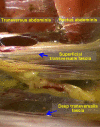Anatomy essentials for laparoscopic inguinal hernia repair
- PMID: 27826575
- PMCID: PMC5075841
- DOI: 10.21037/atm.2016.09.32
Anatomy essentials for laparoscopic inguinal hernia repair
Abstract
Laparoscopic inguinal hernia repair is performed more and more nowadays. The anatomy of these procedures is totally different from traditional open procedures because they are performed from different direction and in different space. The important anatomy essentials for laparoscopic inguinal hernia repair will be discussed in this article.
Keywords: Inguinal hernia; anatomy; laparoscopic repair.
Conflict of interest statement
The authors have no conflicts of interest to declare.
Figures













References
LinkOut - more resources
Full Text Sources
Other Literature Sources
